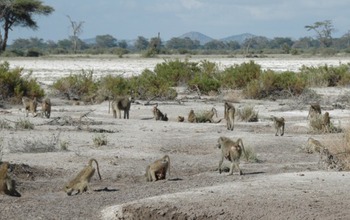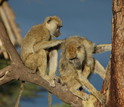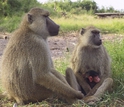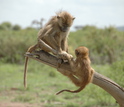Hola amigos: A VUELO DE UN QUINDE EL BLOG., hemos recibido información de la Fundación Nacional de Ciencias de Los Estados Unidos, donde han descubierto que los monos Babuinos, hicieron frente a sequias en el Desierto de Mojave en Kenya.
NSF, nos dice: El dicho "lo que no te mata te hace más fuerte" no puede soportar a un escrutinio científico.Después de las llanuras del sur de Kenia experimentaron una grave sequía en 2009, que tuvo un efecto terrible en la vida silvestre, los investigadores observaron cómo 50 babuinos salvajes hicieron frente a la sequía, y si las condiciones que se enfrentaron en la infancia juegan un papel.
La sabana semiárida del sur de Kenia por lo general recibe un promedio de 14 pulgadas de lluvia al año - similares a gran parte de Nebraska o Kansas - pero en 2009 se redujo a cinco centímetros, menos que el desierto de Mojave.
El año anterior no fue mucho mejor: las lluvias en 2008 se redujo a la mitad de los niveles normales.
La sabana semiárida del sur de Kenia por lo general recibe un promedio de 14 pulgadas de lluvia al año - similares a gran parte de Nebraska o Kansas - pero en 2009 se redujo a cinco centímetros, menos que el desierto de Mojave.
El año anterior no fue mucho mejor: las lluvias en 2008 se redujo a la mitad de los niveles normales.
More information..........
Findings have implications for human health

Baboon group in Amboseli, Kenya, drinking from rainpools that are slowly drying up in a drought.
Credit and Larger Version |
April 1, 2015
The saying "what doesn't kill you makes you stronger" may not hold up to scientific scrutiny.
After the plains of southern Kenya experienced a severe drought in 2009 that took a terrible toll on wildlife, researchers looked at how 50 wild baboons coped with the drought, and whether the conditions they faced in infancy played a role.
The semi-arid savanna of southern Kenya usually receives an average of 14 inches of rain a year--akin to much of Nebraska or Kansas--but in 2009 it fell to five inches, less than the Mojave Desert.
The year before wasn't much better: rainfall in 2008 dropped to half normal levels.
Grasslands withered
The grasslands the animals depend on for food dried up and watering holes disappeared, leaving many animals starving or weak from hunger.
"We lost 98 percent of the wildebeest population, 75 percent of the zebra population and 30 percent of the elephant population," said Susan Alberts, a biologist at Duke University. "It was impossible to go anywhere without smelling death."
Most baboons made it, but the drought left them underweight and many females stopped ovulating.
In a forthcoming paper in the journal American Naturalist, the researchers compared two groups of females--one group born during low rainfall years, the other born during normal rainfall years.
Born in a drought
All females in the study were adults by time of the 2009 drought, but those born in lean times fared worse in 2009 than those born in times of plenty, the researchers found.
"This study demonstrates lifetime fertility reductions for baboons born during stressful conditions or to low-ranking mothers," said George Gilchrist, program director in the National Science Foundation's (NSF) Division of Environmental Biology, which funded the research along with NSF's Divisions of Integrative Organismal Systems and Behavioral and Cognitive Sciences.
"These 'disadvantaged' early life experiences are linked with less resilience to stressful conditions experienced as adults."
During the 2009 drought, baboons born during low rainfall years were 60 percent less likely to become pregnant, whereas pregnancy rates dipped by only 10 percent for females born during normal rainfall years.
Drought babies born to higher-status mothers were less affected by the 2009 event.
"It might be that baboons born to higher-ranked moms have better access to food, or suffer lower levels of social stress," Alberts said.
Implications for human health
The findings also help explain why people who are malnourished in early childhood go on to have higher rates of obesity, diabetes and heart disease as adults.
Some researchers argue that human babies conceived or born in lean times are programmed for food shortages later in life.
They develop a "thrifty metabolism," aimed at storing fat and conserving energy in order to survive starvation.
Things go awry, the thinking goes, only when the environments they experienced as infants and as adults don't match, such as when a child conceived in famine grows up and eats an excess of cheeseburgers, said paper co-author Amanda Lea, a biologist at Duke.
But the baboon fertility study lends support to another idea, namely that kids who don't get enough to eat during their first year of life are simply less resilient as adults than their counterparts.
"The data suggest that early adversity carries lifelong costs," said co-author Jenny Tung, a biologist at Duke.
"It's bad to be born in bad times, but with the right social or economic environment, that can be mitigated," Alberts added.
Jeanne Altmann of Princeton University is also a co-author of the paper.
In addition to NSF, the National Institute on Aging in Bethesda, Md.; Duke University; Princeton University; and the Max Planck Institute for Demographic Research supported the research.
| -- | Cheryl Dybas, NSF (703) 292-7734 cdybas@nsf.gov |
| -- | Robin Ann Smith, Duke University (919) 681-8057 ras10@duke.edu |
Investigators Jenny Tung
Susan Alberts
Susan Alberts
Related Institutions/Organizations Duke University
Related Programs Biological Anthropology

Adolescent female baboon grooming her mother.
Credit and Larger Version

Adult female baboon with a one-day-old infant, sitting with an adult male baboon.
Credit and Larger Version

Infant baboon reaching toward an older juvenile who is feeding.
Credit and Larger Version

Juvenile male baboon holding his young infant brother.
Credit and Larger Versión
The National Science Foundation (NSF)
Guillermo Gonzalo Sánchez Achutegui
Inscríbete en el Foro del blog y participa : A Vuelo De Un Quinde - El Foro!


No hay comentarios:
Publicar un comentario